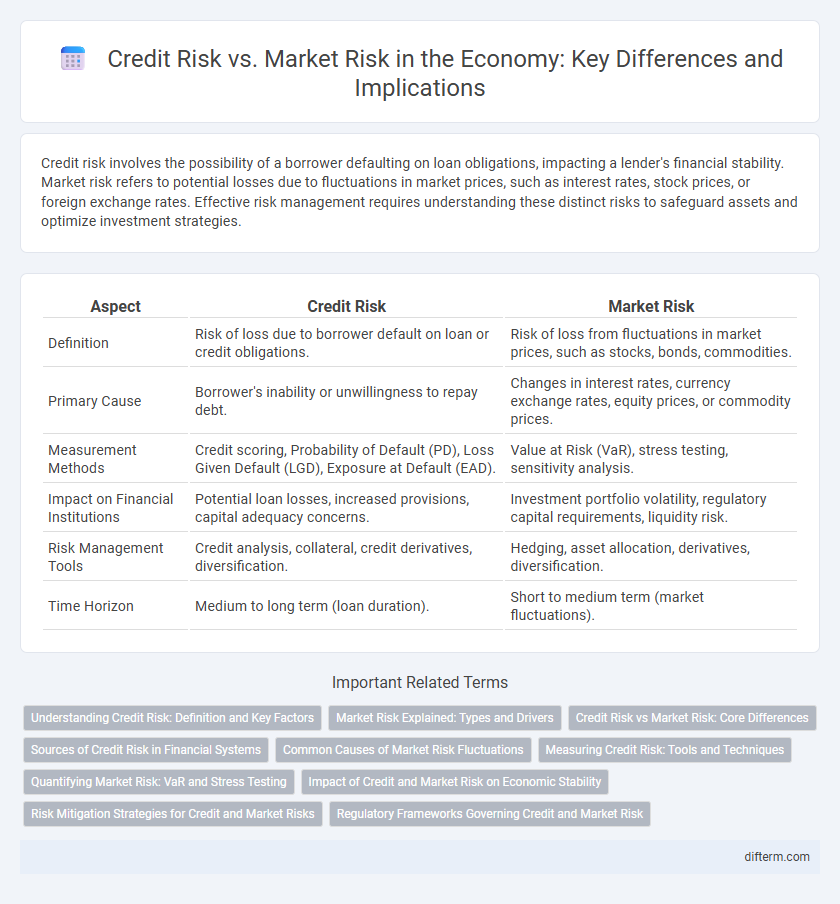Credit risk involves the possibility of a borrower defaulting on loan obligations, impacting a lender's financial stability. Market risk refers to potential losses due to fluctuations in market prices, such as interest rates, stock prices, or foreign exchange rates. Effective risk management requires understanding these distinct risks to safeguard assets and optimize investment strategies.
Table of Comparison
| Aspect | Credit Risk | Market Risk |
|---|---|---|
| Definition | Risk of loss due to borrower default on loan or credit obligations. | Risk of loss from fluctuations in market prices, such as stocks, bonds, commodities. |
| Primary Cause | Borrower's inability or unwillingness to repay debt. | Changes in interest rates, currency exchange rates, equity prices, or commodity prices. |
| Measurement Methods | Credit scoring, Probability of Default (PD), Loss Given Default (LGD), Exposure at Default (EAD). | Value at Risk (VaR), stress testing, sensitivity analysis. |
| Impact on Financial Institutions | Potential loan losses, increased provisions, capital adequacy concerns. | Investment portfolio volatility, regulatory capital requirements, liquidity risk. |
| Risk Management Tools | Credit analysis, collateral, credit derivatives, diversification. | Hedging, asset allocation, derivatives, diversification. |
| Time Horizon | Medium to long term (loan duration). | Short to medium term (market fluctuations). |
Understanding Credit Risk: Definition and Key Factors
Credit risk refers to the potential for a loss resulting from a borrower's failure to repay a loan or meet contractual obligations. Key factors influencing credit risk include the borrower's creditworthiness, financial stability, repayment capacity, and the prevailing economic conditions. Effective credit risk assessment involves analyzing credit scores, debt-to-income ratios, collateral value, and market trends to minimize default probabilities.
Market Risk Explained: Types and Drivers
Market risk refers to the possibility of financial losses due to fluctuations in market prices, interest rates, and exchange rates, impacting portfolios and investments. The primary types include equity risk, interest rate risk, currency risk, and commodity risk, each driven by macroeconomic factors, geopolitical events, and market sentiment shifts. Understanding market risk involves analyzing volatility patterns, correlation among assets, and external economic indicators that influence market behaviors.
Credit Risk vs Market Risk: Core Differences
Credit risk represents the potential loss arising from a borrower's failure to meet debt obligations, directly impacting lenders and financial institutions. Market risk involves the possibility of losses due to fluctuations in market prices, such as interest rates, equity prices, and foreign exchange rates, affecting investment portfolios. Understanding the core differences between credit risk and market risk is crucial for effective risk management and regulatory compliance in the financial sector.
Sources of Credit Risk in Financial Systems
Sources of credit risk in financial systems primarily stem from borrower default due to insolvency, economic downturns, or adverse changes in borrowers' financial health. Counterparty risk arises in lending, trading, and investment activities when the other party fails to fulfill contractual obligations. Concentration risk occurs when exposure is heavily weighted towards a particular borrower, industry, or geographic region, increasing vulnerability to correlated defaults.
Common Causes of Market Risk Fluctuations
Market risk fluctuations commonly arise from interest rate changes, currency exchange volatility, and equity price movements, impacting portfolio valuations directly. Macroeconomic factors such as inflation rates, geopolitical events, and central bank policies also contribute significantly to market risk variability. Unlike credit risk, which centers on counterparty default probability, market risk is driven by broader systemic and market-wide variables affecting asset prices.
Measuring Credit Risk: Tools and Techniques
Measuring credit risk involves evaluating the likelihood of borrower default using tools such as credit scoring models, probability of default (PD), loss given default (LGD), and exposure at default (EAD). Techniques like internal ratings-based (IRB) approaches and credit risk modeling software help quantify potential losses and manage portfolio risk. Stress testing and scenario analysis further refine assessments by simulating adverse economic conditions to predict credit impairment.
Quantifying Market Risk: VaR and Stress Testing
Quantifying market risk primarily involves techniques such as Value at Risk (VaR) and stress testing to assess potential losses under normal and extreme market conditions. VaR estimates the maximum expected loss over a given time frame at a specific confidence level, providing a probabilistic measure of risk exposure. Stress testing complements VaR by simulating severe market scenarios, helping financial institutions evaluate resilience and prepare for low-probability, high-impact events.
Impact of Credit and Market Risk on Economic Stability
Credit risk arises from the potential default of borrowers, leading to severe losses for financial institutions and disruptions in credit availability, which can destabilize economic growth. Market risk involves fluctuations in asset prices, interest rates, and foreign exchange rates, impacting investment portfolios and financial markets' liquidity, thereby increasing economic volatility. Both credit and market risks critically influence economic stability by affecting financial system resilience, investor confidence, and the efficient allocation of capital.
Risk Mitigation Strategies for Credit and Market Risks
Credit risk mitigation strategies include thorough borrower credit assessments, collateral requirements, and credit derivatives such as credit default swaps to transfer exposure. Market risk management relies on diversification, asset-liability matching, and the use of financial instruments like options, futures, and swaps to hedge against price volatility. Both risk types benefit from stress testing and scenario analysis to identify vulnerabilities and strengthen financial resilience.
Regulatory Frameworks Governing Credit and Market Risk
Regulatory frameworks such as Basel III establish stringent capital requirements and risk management standards for both credit risk and market risk, aiming to enhance financial stability. Credit risk regulations primarily focus on assessing borrower default probabilities and maintaining adequate loan loss provisions, while market risk regulations emphasize value-at-risk (VaR) models and stress testing to account for fluctuations in market prices. Supervisory bodies like the Basel Committee on Banking Supervision enforce these regulations to ensure banks hold sufficient reserves against potential losses from credit and market exposures.
Credit risk vs Market risk Infographic

 difterm.com
difterm.com